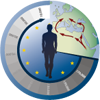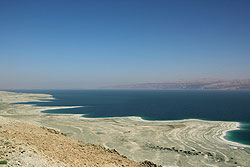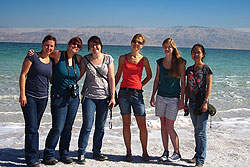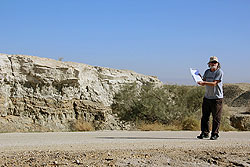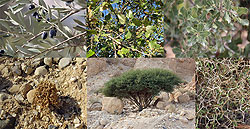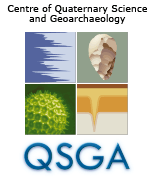In November 2014, the members of the B3 project went to Israel for the Dead Sea Deep Drilling Project (DSDDP) workshop and several short field trips around Israel. It was the first workshop after the ICDP drilling in the Dead Sea in 2010/2011. Researches of the DSDDP team were present and extensive discussions were carried out in the kibbutz Ein Gedi, which is one of the oldest oasis of Israel lying next to the Dead Sea. From B3 cluster, Thomas Litt, Chunzhu Chen, and Andrea Miebach gave talks on the vegetation history of the southern Levant since the Last Interglacial.
After we went for a swim in the hypersalin Dead Sea, we visited several geological outcrops and archaeological sites nearby. Under the guidance of Moti Stein (from the Geological Survey of Israel), we saw sections of the exposed Lisan Formation in Beit HaArava, which were deposited during the Last Glacial, when the lake level was much higher (see Figs. 1–3). The Dead Sea currently has a level of 427 m below sea level (bsl), while Lake Lisan (Last Glacial precursor of Dead Sea) reached ca. 170 m bsl. We explored outcrops of Samra Fm., Lisan Fm., and Ze'elim Fm. in a wadi near Mount Sodom, which is a salt diapir rising since ca. 5 million years. Here we saw the typical wadi vegetation with subtropical savanna plants (e.g., Acacia tortilis; see Fig. 4). Furthermore, we visited the ancient fortification of Masada and the famous Qumran site.
Back in Jerusalem, we had the opportunity to meet our Israeli colleagues also working on Lake Kinneret sediments. Hannah Vossel and Vera Schiebel presented their latest results on diatom and pollen analysis, respectively.
We also visited the famous Soreq Cave (Fig. 5), which is located in a westward direction from Jerusalem and lies in the Mediterranean vegetation zone. Common plants we saw are Quercus calliprinos, Olea europaea, Pistacia lentiscus, Pinus halepensis, Cupressus, Ephedra, Ceratonia, Sarcopoterium spinosum, etc. The cave is famous for its high-resolution oxygen isotope record of its speleothems, and it was used as a benchmark in palaeoenvironmental studies in the southern Levant.
Heading north towards Lake Kinneret, we saw a clear variation of biomes from semi-desert and steppe to Mediterranean forests. In the Gamla Reserve on the Golan Heights, Quercus ithaburensis is one of the dominant tree taxa. Exploring the vegetation and the archaeology of the reserve, we had a nice last day in this interesting and exciting country.
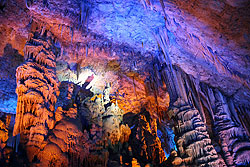 Fig. 5 Inside-view in the famous Soreq Cave. Fig. 5 Inside-view in the famous Soreq Cave.Photo: Hannah Vossel |
